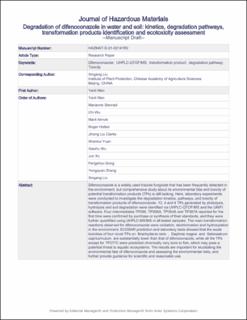| dc.contributor.author | Man, Yanli | |
| dc.contributor.author | Stenrød, Marianne | |
| dc.contributor.author | Wu, Chi | |
| dc.contributor.author | Almvik, Marit | |
| dc.contributor.author | Holten, Roger | |
| dc.contributor.author | Clarke, Jihong Liu | |
| dc.contributor.author | Yuan, Shankui | |
| dc.contributor.author | Wu, Xiaohu | |
| dc.contributor.author | Xu, Jun | |
| dc.contributor.author | Dong, Fengshou | |
| dc.contributor.author | Zheng, Yongquan | |
| dc.contributor.author | Liu, Xingang | |
| dc.date.accessioned | 2021-10-19T13:30:42Z | |
| dc.date.available | 2021-10-19T13:30:42Z | |
| dc.date.created | 2021-06-21T17:06:19Z | |
| dc.date.issued | 2021-06-04 | |
| dc.identifier.citation | Journal of Hazardous Materials. 2021, 418 . | en_US |
| dc.identifier.issn | 0304-3894 | |
| dc.identifier.uri | https://hdl.handle.net/11250/2823927 | |
| dc.description.abstract | Difenoconazole is a widely used triazole fungicide that has been frequently detected in the environment, but comprehensive study about its environmental fate and toxicity of potential transformation products (TPs) is still lacking. Here, laboratory experiments were conducted to investigate the degradation kinetics, pathways, and toxicity of transformation products of difenoconazole. 12, 4 and 4 TPs generated by photolysis, hydrolysis and soil degradation were identified via UHPLC-QTOF/MS and the UNIFI software. Four intermediates TP295, TP295A, TP354A and TP387A reported for the first time were confirmed by purchase or synthesis of their standards, and they were further quantified using UHPLC-MS/MS in all tested samples. The main transformation reactions observed for difenoconazole were oxidation, dechlorination and hydroxylation in the environment. ECOSAR prediction and laboratory tests showed that the acute toxicities of four novel TPs on Brachydanio rerio, Daphnia magna and Selenastrum capricornutum are substantially lower than that of difenoconazole, while all the TPs except for TP277C were predicted chronically very toxic to fish, which may pose a potential threat to aquatic ecosystems. The results are important for elucidating the environmental fate of difenoconazole and assessing the environmental risks, and further provide guidance for scientific and reasonable use. | en_US |
| dc.language.iso | eng | en_US |
| dc.publisher | Elsevier B.V. | en_US |
| dc.rights | Attribution-NonCommercial-NoDerivatives 4.0 Internasjonal | * |
| dc.rights.uri | http://creativecommons.org/licenses/by-nc-nd/4.0/deed.no | * |
| dc.title | Degradation of difenoconazole in water and soil: Kinetics, degradation pathways, transformation products identification and ecotoxicity assessment | en_US |
| dc.type | Peer reviewed | en_US |
| dc.type | Journal article | en_US |
| dc.description.version | acceptedVersion | en_US |
| dc.rights.holder | © 2021 Elsevier B.V. All rights reserved. | en_US |
| dc.source.pagenumber | 13 | en_US |
| dc.source.volume | 418 | en_US |
| dc.source.journal | Journal of Hazardous Materials | en_US |
| dc.identifier.doi | 10.1016/j.jhazmat.2021.126303 | |
| dc.identifier.cristin | 1917466 | |
| dc.relation.project | Norges forskningsråd: 287431 | en_US |
| dc.source.articlenumber | 126303 | en_US |
| cristin.ispublished | true | |
| cristin.fulltext | postprint | |
| cristin.qualitycode | 2 | |

